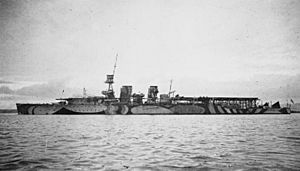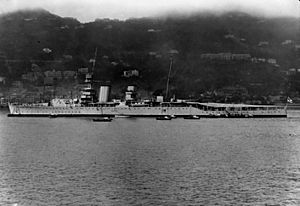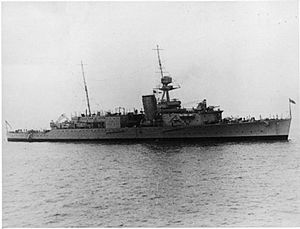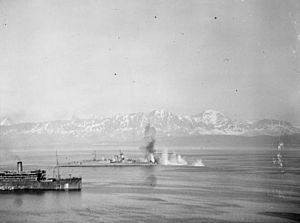HMS Vindictive (1918) facts for kids

Vindictive as an aircraft carrier
|
|
Quick facts for kids History |
|
|---|---|
| Name | HMS Vindictive |
| Ordered | April 1916 |
| Builder | Harland & Wolff, Belfast |
| Yard number | 500 |
| Laid down | 29 June 1916 |
| Launched | 17 January 1918 |
| Completed | 19 October 1918 |
| Commissioned | 1 October 1918 |
| Renamed | June 1918 from HMS Cavendish |
| Reclassified |
|
| Identification | Pennant number: 31 (July 1918); 48 (September 1919); 36 (1920); I36 (1938); D36 (1940) |
| Fate | Scrapped, 1946 |
| General characteristics (as completed 1918) | |
| Class and type | Laid down as a Hawkins-class heavy cruiser |
| Displacement | 9,394 long tons (9,545 t) (light), 12,400 long tons (12,600 t) (deep load) |
| Length | 605 ft (184.4 m) (o.a.) |
| Beam | 65 ft (19.8 m) |
| Draught | 19 ft 3 in (5.9 m) (mean) |
| Installed power |
|
| Propulsion |
|
| Speed | 30 knots (56 km/h; 35 mph) |
| Range | 5,400 nmi (10,000 km; 6,200 mi) at 14 knots (26 km/h; 16 mph) |
| Complement | 648 |
| Armament |
|
| Armour |
|
| Aircraft carried | 6–12 |
HMS Vindictive was a special warship built for the Royal Navy during World War I. She started as a large warship called a Hawkins-class. But while she was still being built, her plans changed. She was turned into an aircraft carrier instead!
Renamed in 1918, Vindictive was finished just before the war ended. She didn't see much fighting then. The next year, she went to the Baltic Sea to help in a campaign against the Bolsheviks. Her aircraft launched many attacks on the naval base at Kronstadt.
After this, Vindictive returned home and was kept in reserve. Later, her flight decks were removed. She was changed back into a cruiser. She even tested a new aircraft catapult. In 1926, she sailed to the China Station.
In 1936–1937, Vindictive was changed again. She became a training ship for cadets. When World War II began in 1939, she was converted into a repair ship. She helped transport troops during the Norwegian Campaign in 1940. Then she supported British ships in the South Atlantic and the Mediterranean. In 1944, she was damaged by a German torpedo near Normandy. After the war, she was sold for scrap in 1946.
Contents
Building a Warship: From Cruiser to Carrier
The Hawkins-class cruisers were designed to chase down enemy ships that attacked trade routes. They needed to be big and fast to do this. They also had a high freeboard to handle rough seas. Vindictive was the last of these ships, ordered in April 1916. She was first named Cavendish.
These cruisers were about 605 feet (184.4 m) long and 65 feet (19.8 m) wide. They had four steam turbines that could make them go up to 30 knots (56 km/h; 35 mph) (about 34.5 miles per hour (55.5 km/h)). They used 12 boilers, some burning oil and some coal. This gave them a long range of 5,400 nautical miles (10,000 km; 6,200 mi) (about 6,213 miles (9,999 km)).
How Vindictive Became an Aircraft Carrier
In 1917, the navy decided they needed more aircraft carriers. They chose to convert Cavendish while she was still being built. They removed some guns and changed the front of the ship. This created a hangar for six reconnaissance aircraft. The roof of the hangar became a 106-foot (32 m) long flying-off deck.
They also removed more guns to make a 193 by 57 feet (58.8 by 17.4 m) landing deck at the back. A special walkway connected the two decks. This allowed planes to be moved around the ship. These changes made the ship a bit lighter than her sister ships. She was ready for sea trials in September 1918.
Vindictive in Action
Cavendish was built in Belfast and launched in January 1918. In June, she was renamed Vindictive. This honored an older ship that had fought bravely in the Zeebrugge Raid. Vindictive joined the Grand Fleet in October, just weeks before World War I ended. She spent the rest of the year testing aircraft.
Fighting in the Baltic Sea
In July 1919, Vindictive sailed to the Baltic. She carried a dozen aircraft, including fighters and bombers. Her mission was to support British forces against the Bolsheviks. On July 6, she ran aground near Reval. It took eight days to free her, after much fuel and ammunition were removed. Luckily, the ship was in a minefield but was not damaged by mines.
Her aircraft group set up an airfield in Finland. They flew reconnaissance missions over the Bolshevik naval base at Kronstadt. Vindictive also served as a depot ship for small torpedo boats. Her planes attacked Kronstadt several times. They helped create a diversion for a successful torpedo boat attack on ships in the harbor. Vindictive left the Baltic in December 1919.
Back to a Cruiser and Training Ship
After the Baltic campaign, Vindictive was put into reserve. It was clear that her design as a "cruiser-carrier" was not ideal. The ship's structure caused too much air turbulence for safe landings.
In 1923, Vindictive began to be changed back into a cruiser. Her flight decks were removed. She kept her hangar and even tested a new aircraft catapult. In 1926, she sailed to the China Station for anti-piracy patrols. She returned home in 1928 and was again placed in reserve.
From 1936 to 1937, Vindictive was changed into a training ship for cadets. Some of her engines and boilers were removed. Her armament was replaced with smaller guns. She could still reach a speed of 24 knots (44 km/h; 28 mph).
A Repair Ship in World War II
When World War II started in 1939, Vindictive was converted into a repair ship. Her guns were removed, and her structure was changed to hold workshops. She was armed with anti-aircraft guns and depth charges.
In 1940, she transported British troops during the Norwegian Campaign. Later, she supported British ships in the South Atlantic and the Mediterranean. In 1942, she avoided torpedoes from a German submarine. In 1944, Vindictive returned home to support the Allied invasion of France. She was damaged by a German torpedo off Normandy.
After the war, Vindictive was put into reserve. She was sold for scrap in 1946 and broken up in Blyth.




